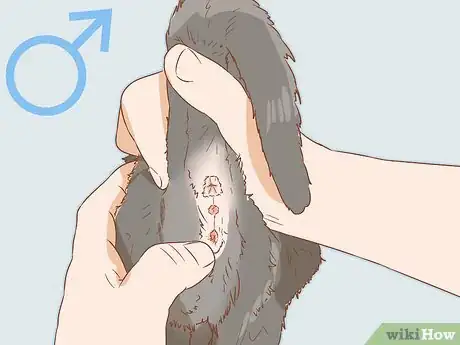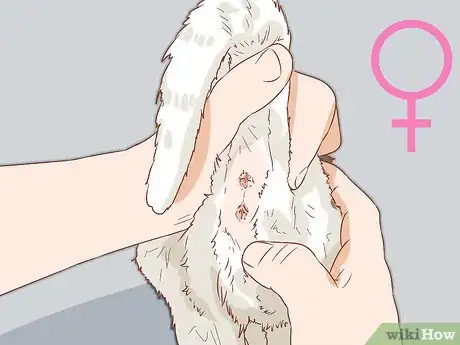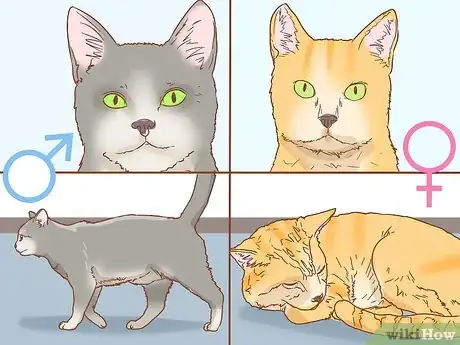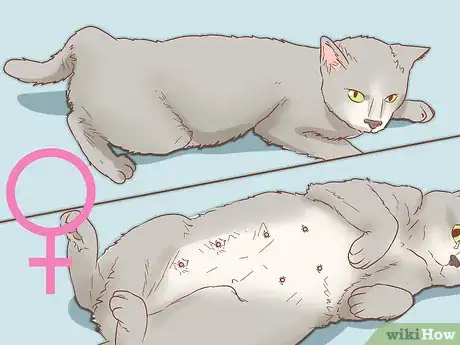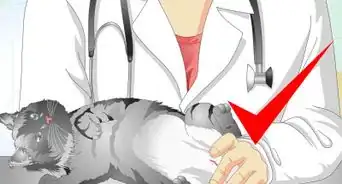This article was co-authored by Pippa Elliott, MRCVS. Dr. Elliott, BVMS, MRCVS is a veterinarian with over 30 years of experience in veterinary surgery and companion animal practice. She graduated from the University of Glasgow in 1987 with a degree in veterinary medicine and surgery. She has worked at the same animal clinic in her hometown for over 20 years.
wikiHow marks an article as reader-approved once it receives enough positive feedback. This article has 22 testimonials from our readers, earning it our reader-approved status.
This article has been viewed 1,626,999 times.
Male and female cats and kittens look and act similarly, so it can be difficult to tell what sex they are just by watching their behavior. If you know what to look for, however, there are several key differences that will allow you to differentiate between the sexes. Newborn kittens will have immature genitalia, so wait until the cats are a few weeks old to determine their sex.
Steps
Determining the Sex by the Cat's Physical Features
-
1Approach the cat or kitten with care. To ascertain the sex of a cat or kitten, it's necessary to pick the cat up. Some cats don't like to be handled, so take a little time to let him or her get comfortable around you.
- Stand or crouch near the cat and let him or her approach you. When the cat comes close, let him or her sniff your hand.
- If the cat seems nervous, you may have to come back later or have a partner help you with the next step.
-
2Lift the cat's tail. Gently pick up the cat and cradle him or her in one arm. Use your free hand to lift the tail so you can examine the genital area.
- If the cat doesn't mind being handled, this may be easiest to perform while sitting on a chair or the couch, so you don't have to worry about dropping the cat.
- If you're working with a partner, have the partner hold the cat securely in both arms while you lift the tail.
- If the cat avoids having his or her tail lifted, try scratching him or her in the area where the tail meets the back. Cats usually lift their tails when they are touched in this spot.[1]
Advertisement -
3Look for genitalia characteristic of a male cat. The surest way to tell the difference between a male and female cat is by examining the cat's physical features below its tail. Begin by looking for male genital features, which can be somewhat easier to spot.
- A male cat will have an anus, scrotum, and penis, while a female cat will have only an anus and urinary tract opening.
- In an entire (or tom) cat, the scrotum is covered with fur and contains two testicles, each typically ranging in size from the size of cherry pits to actual cherries. The scrotum sticks out from the male cat's rear as a fairly obvious pair of bumps. If the cat has long fur, this can make the scrotum more difficult to see, in which case try dampening the fur with water to flatten it down and make the scrotum more obvious.
- A neutered male cat will still have a scrotum, though it will typically be smaller.[2]
- The penis is sited below the scrotum, beneath the skin, and exits at a small furry mound between the cat's thighs. You might imagine a male cat’s genitalia resembling a colon (:).
- A male cat's anus and urinary tract opening are at least 1 inch (2.5 cm) apart, or 1⁄2 inch (1.3 cm) for kittens.
-
4Look for genitalia characteristic of a female cat. If the cat’s genitalia doesn’t appear to match that of a male cat, begin looking for female traits.
- A female cat will have an anus and a urinary tract opening/vulva, with the vulva in the shape of a vertical slit. You can imagine a female cat’s genitalia as resembling a semi-colon (;).[3]
- A female cat will have a shorter distance between anus and vulva, typically about 1⁄2 inch (1.3 cm) apart.
Determining Sex Through Other Differences
-
1Check the color. If you have a litter of kittens, look at the color of the cats; some cat colorations are sex-specific and can help you determine the sex of the cat.
- Cats that are calico or tortoiseshell colored are typically female.
- More orange or ginger colored cats are male than female, but this is not an accurate way to determine a cat's sex.[4]
-
2Watch for sex-specific behaviors among intact (not neutered or spayed) cats. It's easier to tell the sex of intact cats, since they naturally display the habits and characteristics of their sex.
- Male cats that have not been neutered tend to be more aggressive than females and to have larger heads and thick skin. They like to roam, sometimes leaving for a few days at a time. They mark their territory by spraying it with strong-smelling urine.[5]
- Female cats are less likely to spray their surroundings.
-
3Watch for signs that the cat is in heat or is or has been pregnant. Female cats that have not been spayed will go into heat, a state of fertility that enables them to become pregnant, every 3-5 weeks during warm weather (or in a house that’s climate controlled). Cats in heat display recognizable behaviors:
- Making vocal sounds to attract males. The cat may sound like it is in pain or whining.
- Moving the tail to the side to show genitalia or crouching into a receptive posture. The vulva may be secreting a clear discharge.
- Rubbing up against inanimate objects, owners, or other animals more than usual.[6]
- Pregnant female cats have low-hanging, distended bellies.
- Female cats that have given birth may have nipples that protrude from their bellies. Be careful when using nipples to determine sex, since both male and female cats have nipples.
Expert Q&A
-
QuestionI have a ginger, polydactyl cat that is affectionate and loves cuddles. My other cat is also ginger and is submissive to the first cat. Is that one male as well?
 Pippa Elliott, MRCVSDr. Elliott, BVMS, MRCVS is a veterinarian with over 30 years of experience in veterinary surgery and companion animal practice. She graduated from the University of Glasgow in 1987 with a degree in veterinary medicine and surgery. She has worked at the same animal clinic in her hometown for over 20 years.
Pippa Elliott, MRCVSDr. Elliott, BVMS, MRCVS is a veterinarian with over 30 years of experience in veterinary surgery and companion animal practice. She graduated from the University of Glasgow in 1987 with a degree in veterinary medicine and surgery. She has worked at the same animal clinic in her hometown for over 20 years.
Veterinarian Ginger cats can be male or female, and both male and female cats can be submissive to others; therefore, it's not possible to tell what gender your cat is based on this information alone. Your best bet is to compare the rear ends of both cats, and see if they are the same (both male) or different (one male, one female.) If it's tricky to hold both at once, try taking a picture on your phone.
Ginger cats can be male or female, and both male and female cats can be submissive to others; therefore, it's not possible to tell what gender your cat is based on this information alone. Your best bet is to compare the rear ends of both cats, and see if they are the same (both male) or different (one male, one female.) If it's tricky to hold both at once, try taking a picture on your phone. -
QuestionIs it possible for a male kitten's genitalia to be closer than an inch to the anal opening?
 Pippa Elliott, MRCVSDr. Elliott, BVMS, MRCVS is a veterinarian with over 30 years of experience in veterinary surgery and companion animal practice. She graduated from the University of Glasgow in 1987 with a degree in veterinary medicine and surgery. She has worked at the same animal clinic in her hometown for over 20 years.
Pippa Elliott, MRCVSDr. Elliott, BVMS, MRCVS is a veterinarian with over 30 years of experience in veterinary surgery and companion animal practice. She graduated from the University of Glasgow in 1987 with a degree in veterinary medicine and surgery. She has worked at the same animal clinic in her hometown for over 20 years.
Veterinarian Yes, if the kitten is small. It's often helpful with young kittens to compare the separation of the openings with others of the same age. Often this makes things a lot clearer.
Yes, if the kitten is small. It's often helpful with young kittens to compare the separation of the openings with others of the same age. Often this makes things a lot clearer.
References
- ↑ http://www.petmd.com/cat/centers/kitten/health/evr_ct_determining_sex_of_cat
- ↑ http://www.petplace.com/cats/how-to-determine-the-sex-of-your-kitten/page1.aspx
- ↑ http://www.aspcapro.org/sites/default/files/ASPCAKittenSexingFinal.pdf
- ↑ http://www.vetmed.wsu.edu/Cliented/kittengender.aspx
- ↑ http://www.susandaffron.com/should-you-get-a-male-or-female-cat/
- ↑ http://www.pet-informed-veterinary-advice-online.com/cat-in-heat.html#look-heat
About This Article
To determine the sex of a cat, approach the animal carefully and slowly to let it get comfortable with you before you pick it up. Once you have the cat in your arms, hold it with one hand so that its paws are facing the ground, and then gently lift its tail so you can see the genital area. Look at this area to see if the cat has a scrotum, which will look like 2 hairy bumps under the anus. If it does, the cat is male. If the cat doesn't have a scrotum and you can see an anus and a urinary tract opening, the cat is female. For advice on determining the cat's sex through color patterns and behavioral differences, read on!


